Learn all about How to Grow Dragon Fruit in pots and enjoy a fresh harvest of this exotic fruit right in your home for the entire family!
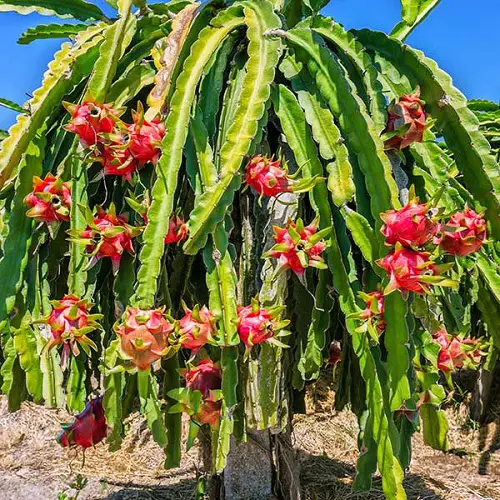
If you love tasty and unique fruits, our guide on How to Grow Dragon Fruit will help you cultivate it easily in a small space!
Other names – Indonesia buah naga, Khmer sror kaa neak, Thai kaeo mangkon, Nanettika fruit, Kaktus madu, Long guo, Cereus triangularis, Thanh long, Strawberry Pear, Cactus fruit, Night blooming Cereus, Belle of the Night, Jesus in the Cradle.
Check out the most exotic fruits in the world here
Dragon Fruit Information
Dragon fruit plant, also famous as pitahaya or pitaya, belongs to the cactus family. It’s a climbing cactus and needs support for growing. The flowers are unique and one of the largest in the world. The blooms only open for one night and exude an inviting fruity fragrance.
Learn about the most aromatic flowers in the world here
Is Dragon Fruit a Cactus?
The dragon fruit is a vine-y cactus belonging to the climbing cacti family of cactaceae and is known for its bright pink pitaya and sweet taste.
Where Does Dragon Fruit Come From?
If you are wondering Where Does Dragon Fruit Come From, the answer to that question is—Dragon fruit is native to Central America and grown throughout Southeast Asia and the subtropical and tropical parts of China, Israel, Vietnam, Malaysia, Thailand, and Nicaragua.
What Does Dragon Fruit Taste Like?
With an edible central fleshy under the relatively thin skin, the flesh of the Dragon Fruit is slightly granular with many black seeds. In texture, it is a cross between watermelon and kiwifruit. With a floral fragrance, the flavor is mildly sweet.
Dragon fruit also offers several health benefits with its antioxidant and vitamin C content. It is a perfect snack for every day as it is low in calories.
Find the Best Blue Fruits here
Dragon Fruit Propagation
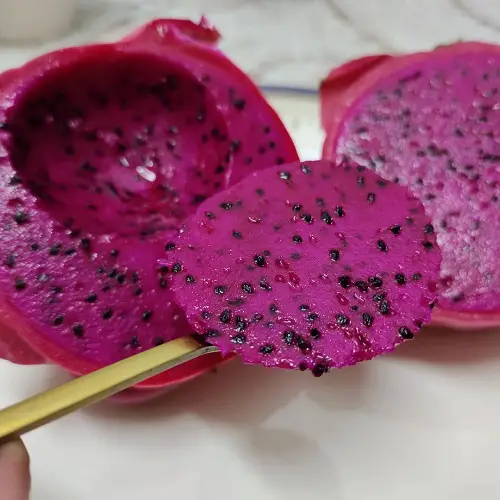
How long does dragon fruit take to grow from seed? Here are the steps to grow dragon fruit from seeds:
Growing Dragon Fruit from Seeds
- Cut open the fruit and scoop out the black seeds from the pulp. Wash the pulp off the seeds. Put these seeds on a moist paper towel and leave them overnight.
- Fill a small pot with well-draining soil. You can make it yourself by mixing one part peat and one part perlite.
- Sprinkle the seed on the soil surface and cover that with a thin layer of growing medium.
- Thoroughly moisten the soil using a sprayer and cover the pot with plastic wrap. Keep the soil moist until seeds germinate, which will take around 15 to 30 days. Ensure it gets plenty of bright and indirect light.
Growing Dragon Fruit in Pots
Growing dragon fruit in the container is fairly easy. This way, you can move the plant and overwinter it to save it from frost. Start the dragon fruit tree in a 10-12 inches deep container and keep repotting yearly or when the plant seems root-bound.
Discover the most drought-tolerant fruit trees here
Types of Dragon Fruit Cactus
Dragon fruit has over ten species, each producing shells, and fruits in color and taste. Also, there are several hybrid types, including ‘Tricia’ (Hylocereus ocamponis and Hylocereus undatus), ‘Edgar’s Baby’ (Hylocereus stenopterus and Hylocereus guatemalensis)
- Hylocereus megalanthus: This dragon fruit is rare to see and grows white, sweet fruit flesh inside a thorny, yellow shell.
- Hylocereus guatemalensis: The dragon fruit shell is pink with greenish fins, and the flesh is bright purple in shade.
- Hylocereus costaricensis: The fruit shell and flesh can look deep pink, blood red, or deep red.
- Hylocereus polyrhizus: This variety produces fruits with a thorny green shell and deep red flesh.
- Hylocereus stenopterus: This variety can produce orange, red, or yellow-colored fruits.
Look at some Gorgeous Purple Foliage Plants here
Requirements for Growing Dragon Fruit
Location
Dragon fruit is a cactus, which means it loves heat and sun. For best growth, pick a spot that gets at least 5-6 hours of bright and direct sunlight every day. Do remember that it will only flower and fruit abundantly if it gets sunlight for the most part of the day.
Soil
For growing dragon fruit, opt for well-draining soil to ensure it never suffers from the problem of root rot. If you want the best fruits, use four parts of garden soil, two parts of coarse sand, and one part perlite.
Avoid adding too much sand, as it will make the growing medium dry out too quickly. The fruit grows best in neutral soil, with a pH of 6 to 7.
Water
Since the dragon fruit is a cactus, water it moderately as you do with other succulents. Water only when the topsoil dries out. When you see it getting full of fruits, make sure the growing medium never dries out completely.
Support
The dragon fruit plant is a climbing cactus and needs support when it becomes mature. It forms aerial roots from the branches and climbs through any nearby structure.
While growing dragonfruit, find something to support your plant. Attach a sturdy trellis or make an arbor to ensure it doesn’t droop, especially when it gets laden with fruits.
Temperature
Dragon fruit can’t live in cool temperatures. Exposure to a temperature below 32 F (0 C) is fatal. Similarly, a temperature above 100 F (38 C) causes difficulty. Keep the plant above 50 F (10 C) in a cool climate.
Learn about Growing Blackberries in Pots here
Dragon Fruit Care

Fertilizer
Fertilize dragon fruit with a balanced liquid fertilizer every month when the plant is active in its growing season. Stop fertilizing in winter. Side-dressing the plant with aged manure or compost can also be done occasionally.
Pruning
Pruning is required to train this plant on the trellis, improve air circulation, prevent fungal infection, and maintain height.
Prune it annually by removing all the overgrowing, decaying, overcrowding, and dead stems saving only the healthier and more productive ones.
Pests and Diseases
There are particularly no pests that nag the plant seriously. However, you must keep an eye on aphids; they feed on young shoots and flower buds.
Fungal diseases and root or fruit rot are possible if the plant is overwatered or exposed to too much rain.
Do Elderberries Grow in Arkansas? Find here
Dragon Fruit Pollination
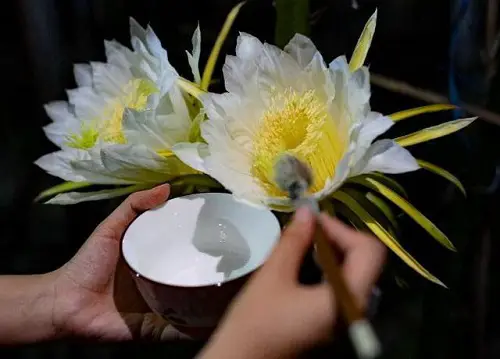
Many dragon fruit varieties are self-pollinating, but some require cross-pollination. If your dragon fruit cannot self-pollinate, you’ll need to grow two or more dragon fruit plants for cross-pollinating.
As dragon fruit flowers are nocturnal, their pollination depends on moths and bats. For assurance, you can also do this manually at night using a brush.
Do you Know You Can Grow Grapes in Containers? Click here
Harvesting Dragon Fruit
- In usual climates, dragon fruit bears fruit multiple times from summer to late fall and probably winter. It depends on the climate.
- If you’re growing it in a temperate region, it’ll fruit between summer to early and mid-fall.
- Your dragon fruit tree will start to produce flowers and fruits once established. This will happen in the second or third year after planting.
- Harvest dragon fruit when its skin color changes from bright green to red or pink. Its fruit is oval,10 to 15 cm long, and forms 30 to 50 days after flowering.
- The pericarp of dragon fruit is rough and scaly and is usually pink in color. However, there are also red or yellow dragon fruits depending on the variety. The flesh is white and contains black seeds.


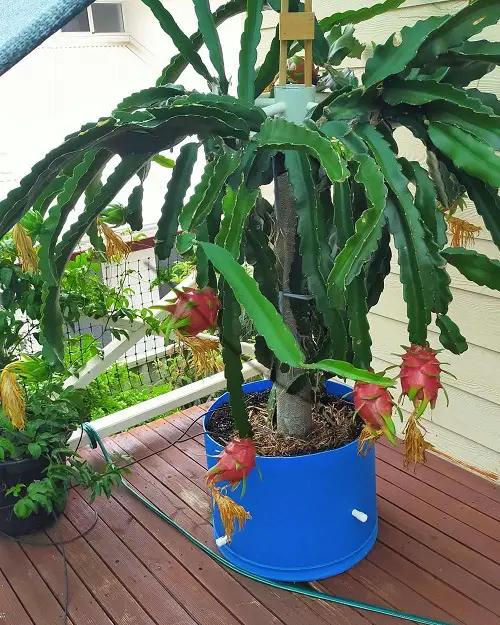
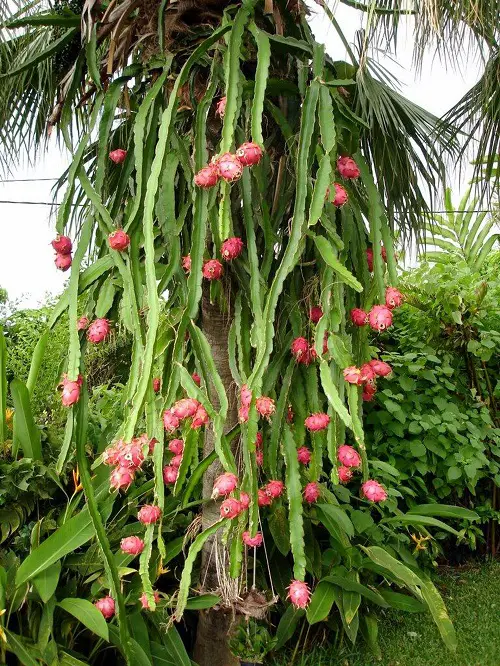
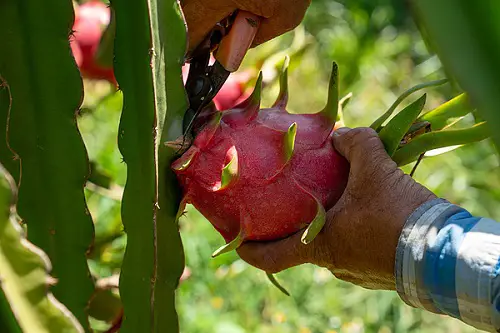

I Wana start dragon fruit in Nepal. If it’s possible to sent seeds or plant plz reply my
Mail we will discuss about it.thank you so much.
Thank you for your interest in our site although we don’t sell seeds or plants.
If you want to grow it, you can buy seeds or plants online. There is a website from your country which is selling dragon fruit seeds you can check it out here. Alternatively, you can buy it from amazon or eBay.
Hi I have one that is huge. I started it from 5 cuttings. It flowered the second year. The flowers are huge and beautiful. We live in the mountains and it gets really cold here so it has always been in the house. It likes a lot of sun and water when sandy soil is dry to touch. It is very hardy so I think it will be fine if the temperature in your house doesn’t get to cold. Good luck.
Hii I have planted dragon fruit seeds in India Delhi. Do I need to cover the soil as it has been a week ??
I live on the west coast of India, when is the right time for me to plant and dragon fruit?
Question for you? Sometimes, my dragon fruit plants has flowers and before it blooms, it dies out with no fruit? Am I doing something wrong? Also, how do you increase the number of flowers/blooms?
Same things happened to me year by year. I had been grown for 15 years still had not bear fruits. I’m not giving up on this.
Same here iv been just patient for it to bear fruit the plant has grown tall and spreading its cactus on the pillar and it’s almost three years now but no fruit as yet .
Your plant is lacking P & K (phosphate and potassium).
take note that dragon fruit plant take in lots of fertilizer.
Good luck…
It sounds like you most likely have a plant that itsnt self pollinating. This just means that you will need pollen from a seperate plant to cross pollinate. Ive done this by hand myself and it worked. I simply searched on the internet how to pollinate a drangonfruit flower. Hope this helps. Best of luck.
Dragon fruit plant is a type of cactus and requires very less watering. It is a hard plant and usually no pests affect it. However, excess watering develops fungus and rot and damages the plant. Water the plant only when soil is completely dry. Enrich the soil with compost, potash, sSSP and very little urea.
Your plant probably is not being pollinated. You can try hand pollinating it. While the flower is open take a cotton swab and from a different plant, gently wipe some pollen off of it, then return to the plant you would like to pollinate, and take that pollen and put it inside the flower. Hope this helps!
Sir, I have completed my m.sc. horticulture, I am interested in growing of dragon fruits. Please provide information and economics of cultivation
hi this is abdul i will start dragon plant please tell me complete details.
I have grown black java plum ( jamun) about couple years grow from seeds. please can advice how long does it take have fruit. one of the plant is shredding leaves. i have grown plant in UK
Dragon fruit plants are actually a tropical plant and you may need to water it more than a normal cactus. Also, unless you have the particular bats or rodents in your area for pollination, you will need to hand pollinate the flowers when they bloom at night. Some varieties bloom more than once before the flower dies. I live in the sun-tropics and my dragon fruit likes full sun, not partial. Thanks.
Thank you for this information. I will begin the experiment.
I live in south fl. Neighbor just gave me a dragon fruit plant. In a small pot. Should i replant to nigger pot or can i divide this plant into 2 or more?
Do I need to have two plants to get fruit of dragon fruit cactus?
one plant will do as the same flower can pollinate itself.
You may have a plant that is not self fertile. If you can get another plant, use a small brush to move pollen from one plant to another. Or if you know someone with another plant, you both can collect pollen and exchange it. For more flowers, use a balanced fertilizer 15-15-15 or 10-10-10.
I have a worm like skinny long thing growing off the cactus. what is that?
Is it off white skinny and pointy? Maybe you have a few growing off one of the cactus vines?
Check online for pictures of roots growing off the limbs, they are looking to grab something to climb up o. And those “fingers” help support them by holding on to walls and more.
Can I use the two flowers from same plant to polinate, or do I need two separate plants?
you can pollinate by using the same flower.
Some plants are self fertile, most require a different plant.
AliExpress sells dragon fruit seeds lots of different colors very cheaply
Can it be grown in Canada? Any special requirements?
I would like to plant dragon fruit in Fiji could you please tell me when Is the right time to plant
I would like to grow one in Wisconsin,US How should I attempt this?
hi, Samantha~
I brought home a cutting from my son in California, last year. (He grows EVERYTHING!!!) I live in WA, so it’s a potted indoor plant, just as you will need. I have it near a southern window, so it gets plenty of light, and it seems to be happy. Growing happily, with lots of support, it looks like an elongated bowl of green spaghetti :-) About 18″ tall, but if I stretched out all the branches & tendrils…? Matt’s is about 6 1/2′ tall, in a huge pot on his outdoor patio. Mine is still too young to bloom yet, but I’m very hopeful for the future. I’ll probably bring back another piece when I go down for Christmas, next week, just in case. Maybe a piece of his Buddha Hand, too! :-)
Best wishes, Marina
How long does a plant take to bear fruit?
hi, Samantha~
I brought home a cutting from my son in California, last year. (He grows EVERYTHING!!!) I live in WA, so it’s a potted indoor plant, just as you will need. I have it near a southern window, so it gets plenty of light, and it seems to be happy. Growing happily, with lots of support, it looks like an elongated bowl of green spaghetti :-) About 18″ tall, but if I stretched out all the branches & tendrils…? Matt’s is about 6 1/2′ tall, in a huge pot on his outdoor patio. Mine is still too young to bloom yet, but I’m very hopeful for the future. I’ll probably bring back another piece when I go down for Christmas, next week, just in case. Maybe a piece of his Buddha Hand, too! :-)
Best wishes, Marina
MSUEH
Are yo aware of Australia’s plant quarantine laws? I hope that you are following correct procedure. It is easy to source plants in Perth.
I also want to grow dragon fruit in south Africa how can I do it
I live in Canada, I planted seeds in January from fruit I bought at the supermarket, I now ha e 20 plants ranging from 1cm to 25cm, in reported the bigger one in 3″ pots, when should I transplant them in larger one? Thanks
Your plant probably is not being pollinated. You can try hand pollinating it. While the flower is open take a cotton swab and from a different plant, gently wipe some pollen off of it, then return to the plant you would like to pollinate, and take that pollen and put it inside the flower. Hope this helps!
How old b4 the plant bears fruit.
I have just been given two cuttings from red dragon fruit. Wish me luck. I live in sub tropical eastern coast of Australia. Fingers crossed
Hi friends
I have planted a dragon fruit tree. As I am a new planter I think that I may over water the tree & I found that the root stem of the tree starts rotten, now what I can do? Do I uproot the tree & plant the upper part of the plant
Has anyone tried growing dragon fruit in Canada?
I live in south texas (Corpus Christi) and took cuttings from alarge plant growing on a chain link fence started them in small pots then transplanted into larger pots ( 30 gallon plastic barrel) last summer mixed sandy loam potting soil and chicken manure. It is now July and I am about to start harvesting fruit approx. one year later
What all precautions to be taken in the rainy season?
I live in Southern California, just planted 3 robust & rooted cuttings, they are each about 1-2ft tall, planted on a support that is 5 foot tall and has wood supports that look like a clothes lines square on top so cuttings can grow thru and have support later on for heavy branches & fruit. It’s in a place in my carport above an embankment that gets plenty of sunlight but is surrounded on 3 sides with wood walls, so it’s protected… we’ll see how it does, I did use a great Fox Farms soil w/ bat guano & worm casings, perlite and heavy sand. Here’s hoping in a season or two we start seeing some growth pattern that will bear fruit! can’t wait!! Happy Planting and self sustaining everyone! M~